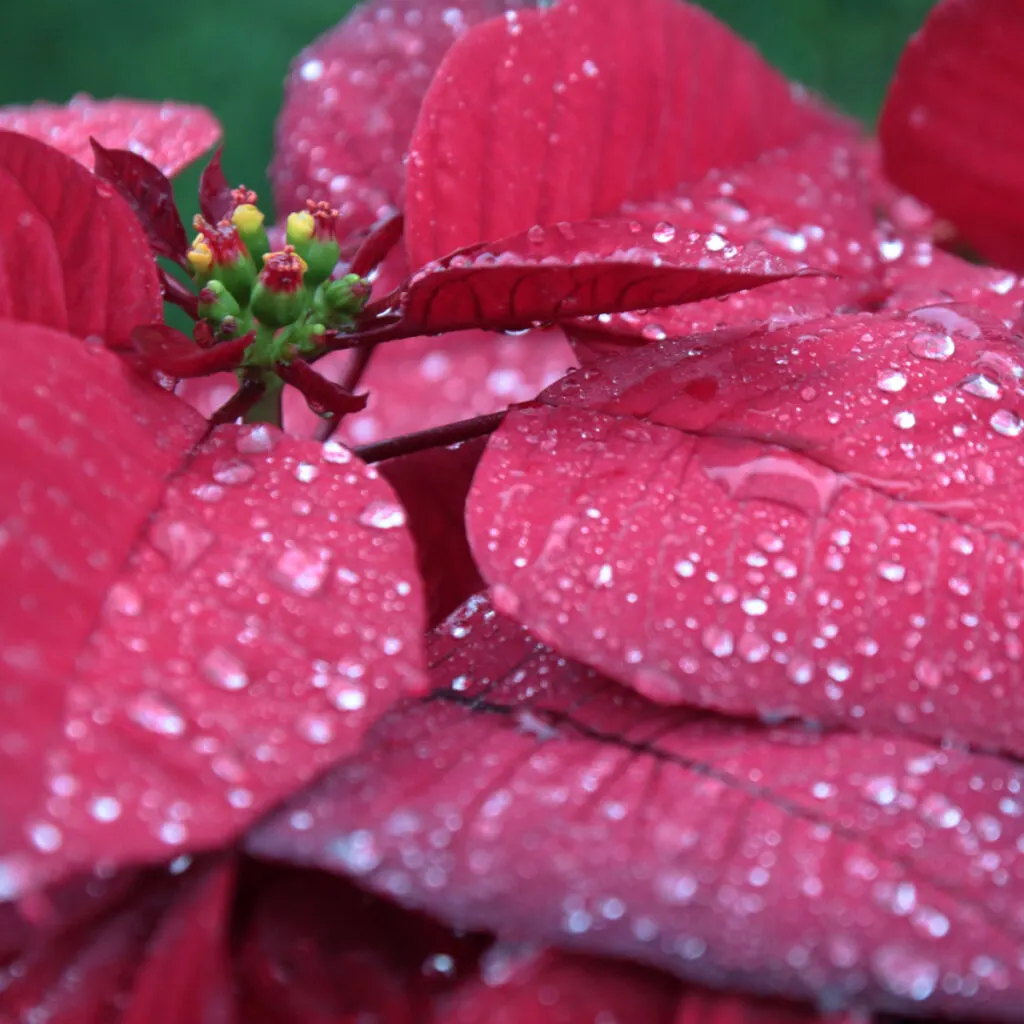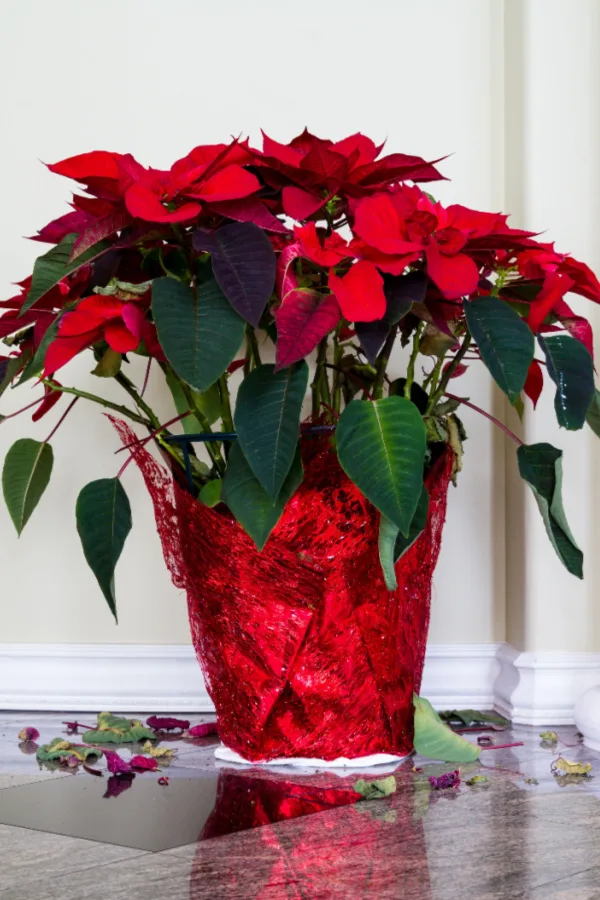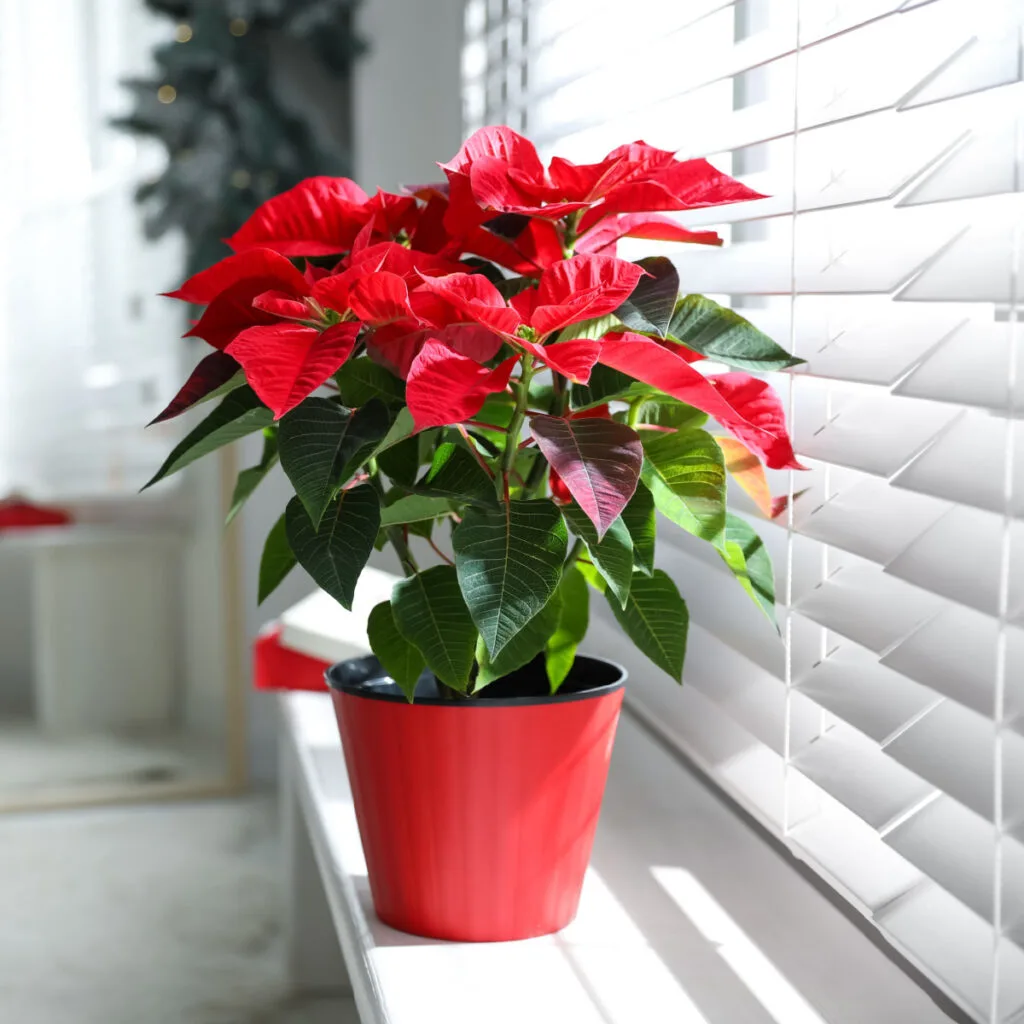Did you know that how you water your poinsettias during the holiday season is one of the biggest factors of all in determining just how long your plant will keep it’s gorgeous colorful leaves in place throughout the holiday season – and that misting your poinsettia regularly can play a huge role in that too?
Poinsettias are one of the most popular plants for filling homes with holiday color and cheer. With varieties that can be found in traditional red, white or a multitude of other festive hues, they are certainly a decorating showstopper.
Of course, when it comes to poinsettias, that “showstopper” status only applies when their foliage is full of bright, vibrant color. And for poinsettias, in order to have them be at their brightest and most vibrant, it’s vital to give them the water they need – and in the way they need it most!

Although water is critical for all living plants, when it comes to poinsettias, the amount of hydration they receive is absolutely crucial. Especially when determining if the plant will stay bright and beautiful all holiday season long – or have its leaves fade and fail well before Christmas dinner ever makes it to the table.
Unfortunately for poinsettias, they happen to be one of the most incorrectly watered houseplants of all. Not just when it comes to watering the plant at the root level – but also in providing moisture to the most important part of all – its leaves!
How A Poinsettia Blooms – And Why Water Is So Important
We will take a look in just a moment on the best way to water and mist your poinsettia for maximum color and bloom time – but first, it’s important to know why water is so vital for a “blooming” poinsettia more than any other houseplant.
A poinsettia gets its bright hues from bracts and not blooms. Bracts are modified leaves that form on the plant. The bracts then change color when conditions are right, giving the illusion the plant is flowering. Bracts do have a tiny, yellow flower that forms in the center – but it is anything but flashy.

Because it is the leaves of the plant that provide the color and not blooms or flowers, proper hydration plays a more critical role in keeping the plant bright and full of life. Why? Because a leaf consists of mostly water. And when too little or too much water is supplied, leaves are usually the first to show the damage.
When a flowering hanging basket dries out in the summer, it is its leaves that droop and wilt first. The same goes for a tomato plant growing in the hot summer sun as it dries out. But if either get too much water and their roots become soggy – those same leaves turn yellow and weak.
This same type of “leaf” stress is exactly what can happen to poinsettias. And since their leaves are the very thing that provide them with their color, it can cause the plants to look less than their best – and lose their color much faster.
How To Water Poinsettias – Keeping Poinsettia’s Blooming Bright
Watering For Success – How To Water Poinsettias
When a poinsettia plant blooms poorly, improper watering is almost always the leading cause. Whether it be underwatering – or over watering. Although both can hurt the plant’s performance, it’s actually usually overwatering that poses more issues for poinsettias.
Listen In Below To Our Podcast On Poinsettia Care!

So how often should you water poinsettias? And how do you make sure you don’t over or underwater? As it turns out, there are actually two ways you should be hydrating your poinsettias. The first is at the base of the plant. And the second method is by misting the leaves of your poinsettias regularly.
Watering A Poinsettia At The Base – How To Water Poinsettias
The key with watering your poinsettia at its base is to water enough to get the soil moist but not saturated. Poinsettias are tropical plants. That means they like moisture and humidity. But what they don’t like is to sit in soggy soil.
For best results, water your plant when the soil is about half dried out. When watering, water enough that water trickles out of the bottom and then stop. At this point, do not allow any water that ran through to sit in a saucer or tray under the plant.
This can result in the plants roots soaking it back in and making the soil too wet. The key is to keep your soil near 50 to 75% moist. And when it drops below the 50% mark, it’s time to water. In most cases, the plants will need water every two to three days to achieve this. It can vary due to room temperature and humidity.

The best way of all to know the moisture level of your soil is with a soil moisture meter. These inexpensive meters are actually great for using on houseplants, hanging baskets and all kind of container plants. They give an instant reading with a probe down in the soil to tell you the exact soil moisture level. Affiliate Link : Instant Read Moisture Reader
Misting A Poinsettia – How To Water Poinsettias
Misting takes watering to a whole new level for your poinsettia. As a tropical plant, it loves humidity. And by misting the leaves, you can provide hydration and humidity all at the same time. Even better, you do so without risking saturating the soil.
Every few days, take a spray bottle filled with water and mist the leaves of your poinsettia. Do not over soak, but make sure all of the leaves are lightly moist.
When misting, always be sure to use untreated water. City or treated water can have harmful chemicals and salts that can shorten bloom times. Distilled or tap water that has not been treated works great for misting.
Believe it or not, this one simple step can extend the life of your bracts by weeks. All by simply hydrating them with a few seconds of work every few days. Who knew it could be so simple!
Other Factors – How To Water Poinsettias
In addition to providing just the right amount of water, there are a few other factors that can affect poinsettias blooming time. At the top of the list is making sure your plants are getting enough light.
When poinsettia bracts are in bloom, they need to get at least 6+ hours of indirect light each day. If displaying in a dark room or hallway, move the plants each day where they can get some light. Without enough light, the bract color and life can be cut in half or more.
It’s also important to locate your poinsettia plants out of the way of excessive heat. Placing plants near air vents and near fireplaces will dry plants out quickly. It will also shorten the bract life quickly. The same goes for placing them near cool drafts or doors that open to the outdoors frequently.
Last but not least, always be sure to remove the shiny foil that the plants are often wrapped in. When covering the bottom of a pot, it can hold excess water and moisture in. If you want the foil look, be sure to at least cut the bottom foil off to let water pass through.
Here is to watering and misting your poinsettias perfectly this year. And even more, to having your poinsettia plants blooming all through the holiday season! For more holiday plant information – check out our article How To Keep Your Christmas Cactus Healthy – Before & After Christmas!
Happy Gardening! Jim and Mary
Jim and Mary Competti have been writing gardening, DIY and recipe articles and books for over 15 years from their 46 acre Ohio farm. The two are frequent speakers on all things gardening and love to travel in their spare time.
As always, feel free to email us at thefarm@owgarden.com with comments, questions, or to simply say hello! You can sign up for our free email list in the subscribe now box in the middle of this article. Follow us on Facebook here : OWG Facebook. This article may contain affiliate links.

